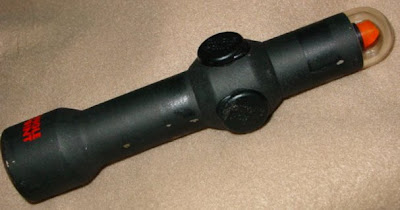Dry firing--and the ammo shortage
Since there isn't much ammo to be had these days, I thought I would talk a bit about dry firing. Those new to shooting may not be familiar with the idea. It is practicing your shooting, but without ammunition. It is beneficial practice; many credit it with improving their skills because they can practice everything repeatedly, making their operations of the firearm precisely correct, without the distraction of the bang and the kick. Some have found it very useful in getting over a tendency to flinch.
With the pistol, you can practice drawing, aiming and trigger pressing. With the rifle you can practice mounting the gun, aiming and pressing, and you can practice aiming and pressing in the various firing positions. You can become adept and efficient in looping up with a firing sling before you let anyone see you do it at the range.
All four gun safety rules apply at all times when you are dry firing, as of course they do at all other times.
Rule Number One is "All guns are always loaded." Of course your gun is not loaded when dry firing, that is the point of the exercise, but the plain intent of the rule is that you treat every gun as a loaded gun. That way there can be no accidents of the kind followed by a plaintive "But I didn't know it was loaded." If you always act on the basis that the gun is loaded and presume it is even when you're sure it isn't, you will never have a problem like that.
Because you are treating the gun as a loaded gun, you must--must--use a safe backstop when dry firing. That is Rule Four. "Always be sure of your target and what is beyond it." The rule speaks to the need for target identification and also the questions of backstop and danger to what is downrange. See also Rule Two, "Never allow the muzzle to cover anything you are not willing to destroy." If a shot were, somehow, to be fired from your empty gun, nothing important would be harmed. That is because we presume it is loaded.See how this gun safety stuff all works together?
My own setting for dry firing has the muzzle pointed at a cinder block basement wall, behind which is earth. It would be an annoyance if I damaged the wall, for I would have to fix it, but it would be no tragedy. I am not exactly "willing to destroy" a block in my wall but I am not unwilling either: Better that than something else.
Rule Three is "Keep your finger OFF the trigger until your sights are ON the target." Dry firing is a good opportunity to practice that one and make it instinctive. This rule, which would by itself eliminate the cause of most accidents, is justified by common sense. There is no need to fire if you are not lined up on the target, thus no need for a finger on the trigger, and careless fingers placed where they have no need to be have fired many, many unintended shots, occasionally with dreadful consequences.
The most valuable aspect of dry firing is observing your sight picture as you operate the trigger.
The sight picture should not move when the hammer drops. That is to say, it should not move any more than it does when you are holding, steady as you can, on the target. Releasing the shot without jerking, flinching or tensing is a good skill for any shooter to have and essential to anyone who wants to be an outstanding shot. The shooter who knows danged well where his sights were at the instant the striker fell is the one who knows what he is doing. Watching the sight and observing where it was when the gun clicked or the shot fired is what is known as "calling your shots." Get into the habit.
Of course to call your shots you need a target on the wall--some definite point of aim. For best results your point of aim should be rather small--not the extra-large portrait of that late uncle you never particularly liked, but something small like a Post-It or a sticky dot.
Snap caps
Some guns are prone to damage from being snapped on an empty chamber. Others are unaffected by it. Absent the manufacturer's assurance that dry firing won't hurt anything, use snap caps, which are inert dummy cartridges, spring loaded to absorb the blow of the firing pin.
Score one for the revolver guys
A revolver operates the same way in dry fire as in live fire. That makes the old wheel gun convenient for dry fire practice because you do not have to cock or reset anything, in a way that differs from what you would do if shooting live ammo. You can't say that for most auto pistols. Just thought I'd throw that in there. While the revolver is superseded as a military sidearm and police duty weapon, I happen to think it is still extremely well suited to personal defense, and especially concealed carry. Its advantage is in its simple and consistent operation. But I suppose I'll get up on that hobby horse some other time.
Laugh at the ammo shortage
You can get in lots and lots of useful practice without expending ammunition. When you finally get back to the range, with some ammo to spare for some serious practice shooting, you will find that dry firing practice has helped you, perhaps more than you had imagined.


Comments
Post a Comment